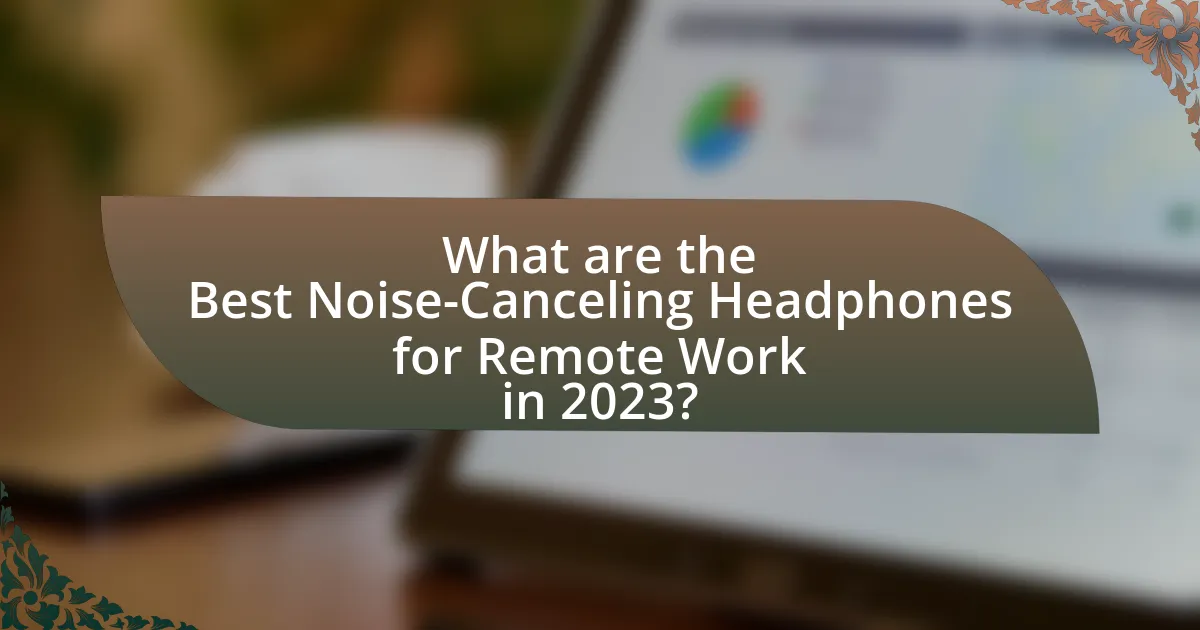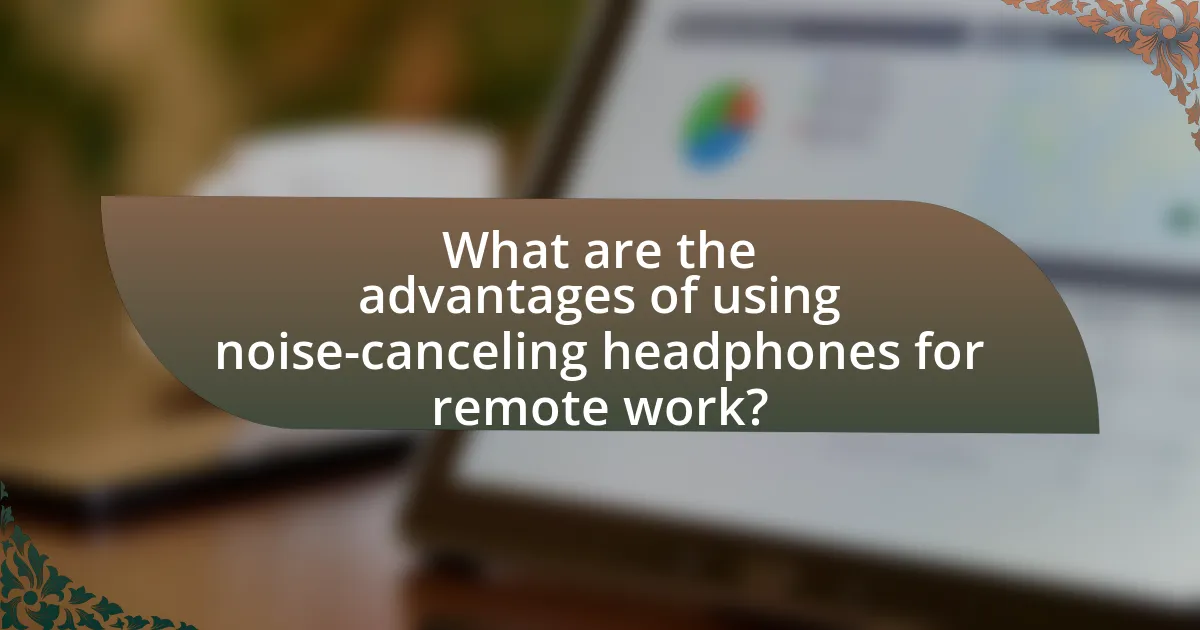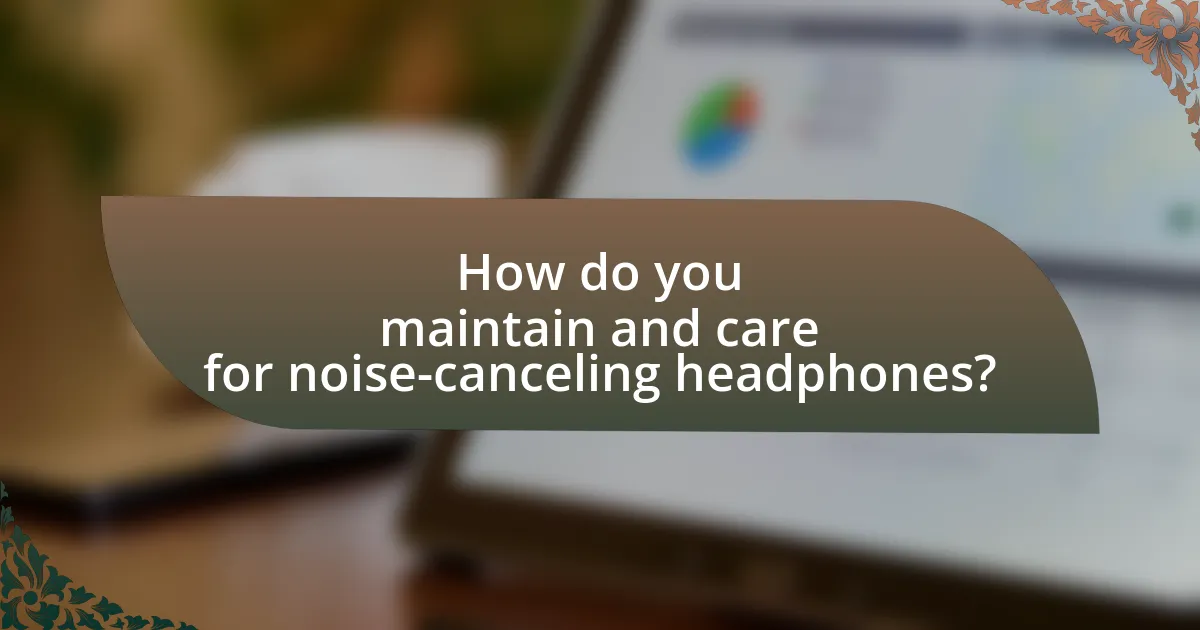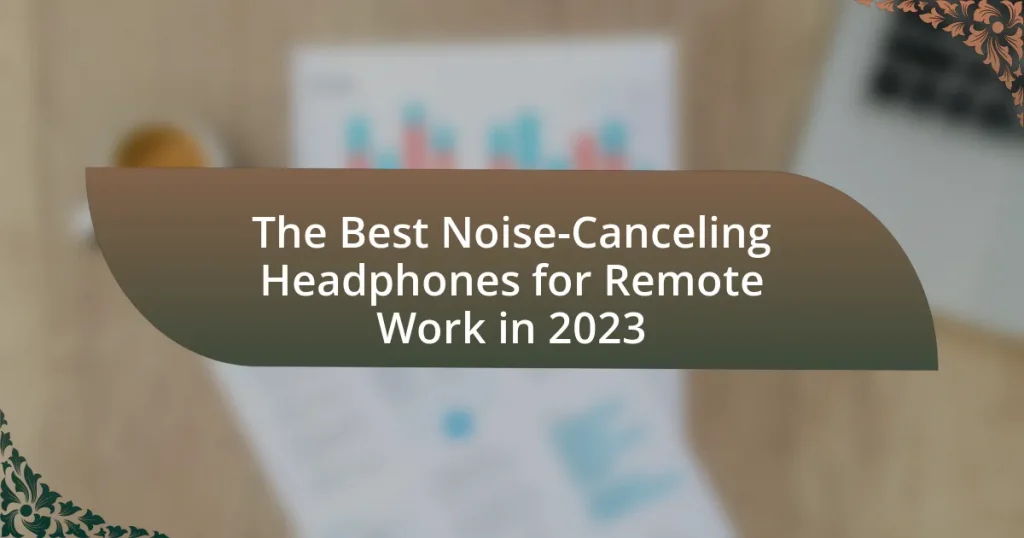The article focuses on the best noise-canceling headphones for remote work in 2023, highlighting top models such as the Sony WH-1000XM5, Bose Noise Cancelling Headphones 700, and Apple AirPods Max. It discusses how these headphones enhance productivity by reducing ambient noise, improving focus, and facilitating clear communication during virtual meetings. Key features contributing to effective noise cancellation, sound quality, comfort, and battery life are examined, along with tips for choosing the right headphones and maintaining them. Additionally, the article addresses potential downsides of noise-canceling technology and offers troubleshooting advice for common issues.

What are the Best Noise-Canceling Headphones for Remote Work in 2023?
The best noise-canceling headphones for remote work in 2023 are the Sony WH-1000XM5, Bose Noise Cancelling Headphones 700, and Apple AirPods Max. The Sony WH-1000XM5 features industry-leading noise cancellation technology, up to 30 hours of battery life, and exceptional sound quality, making it ideal for focused work environments. The Bose Noise Cancelling Headphones 700 offer adjustable noise cancellation levels, a comfortable fit, and excellent call quality, which is crucial for remote communication. The Apple AirPods Max combines high-fidelity audio with effective noise cancellation and seamless integration with Apple devices, enhancing productivity for users within the Apple ecosystem. These models have been consistently rated highly by users and experts alike for their performance and comfort in remote work settings.
How do noise-canceling headphones enhance remote work productivity?
Noise-canceling headphones enhance remote work productivity by significantly reducing ambient noise, allowing users to concentrate better on tasks. Studies show that distractions from background sounds can decrease productivity by up to 30%, while noise-canceling technology effectively blocks these interruptions. This leads to improved focus, increased efficiency, and a more conducive work environment, ultimately resulting in higher output and better quality of work.
What features contribute to effective noise cancellation in headphones?
Effective noise cancellation in headphones is primarily achieved through active noise cancellation (ANC), passive noise isolation, and sound quality. Active noise cancellation utilizes microphones to detect external sounds and generates sound waves that are the exact opposite, effectively canceling out unwanted noise. Passive noise isolation involves the physical design of the headphones, such as cushioned ear cups that block ambient noise. High-quality sound reproduction is also crucial, as it ensures that the audio experience remains clear and immersive despite the noise cancellation features. Studies have shown that headphones with both ANC and passive isolation can reduce ambient noise by up to 30 decibels, significantly enhancing the listening experience in noisy environments.
How does sound quality impact the remote work experience?
Sound quality significantly impacts the remote work experience by influencing communication clarity and focus. High-quality sound allows for clear conversations during virtual meetings, reducing misunderstandings and enhancing collaboration. Research indicates that poor audio quality can lead to increased frustration and decreased productivity, as employees struggle to hear and engage effectively. For instance, a study by the International Journal of Human-Computer Interaction found that participants reported a 30% decrease in task performance when audio quality was subpar. Thus, investing in quality sound equipment, such as noise-canceling headphones, can improve overall work efficiency and satisfaction in remote settings.
What are the key factors to consider when choosing noise-canceling headphones?
When choosing noise-canceling headphones, key factors include sound quality, comfort, battery life, and noise-canceling effectiveness. Sound quality is crucial as it determines the clarity and richness of audio, which is essential for remote work. Comfort is important for prolonged use, especially during long meetings or work sessions; headphones should have adjustable headbands and cushioned ear cups. Battery life affects usability; headphones should last at least 20 hours on a single charge to accommodate full workdays. Noise-canceling effectiveness is vital for minimizing distractions; look for models with adaptive noise cancellation that adjusts to the environment for optimal performance.
How important is comfort for long hours of use?
Comfort is crucial for long hours of use, particularly in the context of noise-canceling headphones for remote work. Extended periods of wear can lead to discomfort, which negatively impacts focus and productivity. Research indicates that ergonomic design significantly enhances user experience; for instance, a study published in the Journal of Ergonomics found that comfortable headphones reduce fatigue and improve concentration during prolonged use. Therefore, selecting headphones with adequate padding, adjustable features, and lightweight materials is essential for maintaining comfort over long durations.
What battery life should you expect from noise-canceling headphones?
Noise-canceling headphones typically offer a battery life ranging from 20 to 40 hours on a single charge. For instance, many popular models, such as the Sony WH-1000XM4, provide up to 30 hours of playback with active noise cancellation enabled. This range is supported by various manufacturers, indicating that users can expect substantial usage time before needing to recharge, making them suitable for extended remote work sessions.
What are the top-rated noise-canceling headphones for remote work in 2023?
The top-rated noise-canceling headphones for remote work in 2023 are the Sony WH-1000XM5, Bose Noise Cancelling Headphones 700, and Apple AirPods Max. The Sony WH-1000XM5 features advanced noise cancellation technology and up to 30 hours of battery life, making it ideal for long work sessions. The Bose Noise Cancelling Headphones 700 offer excellent sound quality and customizable noise cancellation levels, providing a tailored listening experience. The Apple AirPods Max combines high-fidelity audio with effective noise cancellation and seamless integration with Apple devices, enhancing productivity for remote workers. These models have received high ratings from users and experts alike, confirming their effectiveness for remote work environments.
What makes the Sony WH-1000XM4 a popular choice?
The Sony WH-1000XM4 is a popular choice due to its industry-leading noise cancellation and superior sound quality. This model features Adaptive Sound Control, which automatically adjusts noise-canceling levels based on the user’s environment, enhancing the listening experience. Additionally, it offers up to 30 hours of battery life on a single charge, making it ideal for long work sessions. The headphones also support high-resolution audio and have a comfortable design, which is essential for extended use. These features collectively contribute to its high ratings and widespread acclaim among users seeking effective noise-canceling solutions for remote work.
How does the Bose Noise Cancelling Headphones 700 compare?
The Bose Noise Cancelling Headphones 700 are superior in noise cancellation and sound quality compared to many competitors in the market. They feature an adaptive noise cancellation system that allows users to adjust the level of ambient sound, which is particularly beneficial for remote work environments. Additionally, the headphones provide clear voice pickup through an advanced microphone system, making them ideal for calls and virtual meetings. According to reviews, the Bose 700 outperforms models like the Sony WH-1000XM4 in terms of comfort and usability, with a more intuitive touch control interface.

What are the advantages of using noise-canceling headphones for remote work?
Noise-canceling headphones provide significant advantages for remote work by enhancing focus and productivity. These headphones effectively reduce ambient noise, allowing users to concentrate better on tasks without distractions from their environment. Studies indicate that noise-canceling technology can decrease background noise by up to 30 decibels, which is particularly beneficial in home office settings where interruptions are common. Additionally, using noise-canceling headphones can lead to reduced stress levels, as a quieter workspace contributes to a more comfortable and efficient working atmosphere.
How do noise-canceling headphones improve focus and concentration?
Noise-canceling headphones improve focus and concentration by actively reducing ambient noise, allowing users to create a quieter environment conducive to productivity. This technology works by using microphones to pick up external sounds and generating sound waves that are the exact opposite, effectively canceling out the noise. Research indicates that reduced background noise can enhance cognitive performance; for instance, a study published in the Journal of the Acoustical Society of America found that participants using noise-canceling headphones performed better on tasks requiring sustained attention compared to those in noisy environments. Thus, noise-canceling headphones facilitate a more focused work atmosphere, essential for remote work efficiency.
What role does ambient noise reduction play in productivity?
Ambient noise reduction significantly enhances productivity by minimizing distractions in work environments. Studies indicate that reduced ambient noise levels can lead to improved focus and concentration, allowing individuals to complete tasks more efficiently. For instance, research published in the Journal of Environmental Psychology found that participants exposed to lower noise levels performed better on cognitive tasks compared to those in noisier settings. This demonstrates that effective noise reduction directly correlates with increased work output and quality.
How can noise-canceling headphones help in virtual meetings?
Noise-canceling headphones enhance virtual meetings by significantly reducing background noise, allowing users to focus on the conversation. This technology employs active noise control, which uses microphones to pick up ambient sounds and generates sound waves that cancel them out. Studies show that using noise-canceling headphones can improve concentration and reduce distractions, leading to more productive meetings. For instance, a report from the Journal of the Acoustical Society of America indicates that participants using noise-canceling headphones experienced a 30% increase in comprehension during audio tasks compared to those without such devices.
What are the potential downsides of using noise-canceling headphones?
The potential downsides of using noise-canceling headphones include discomfort during prolonged use, a sense of isolation, and potential safety hazards. Prolonged use can lead to ear fatigue or discomfort due to the pressure created by active noise cancellation technology. Additionally, users may experience a feeling of isolation from their surroundings, which can be detrimental in environments where awareness of external sounds is necessary, such as when walking in public spaces. Furthermore, noise-canceling headphones can pose safety risks by blocking out important auditory cues, such as alarms or approaching vehicles, which can lead to dangerous situations.
Can prolonged use lead to discomfort or hearing issues?
Prolonged use of noise-canceling headphones can lead to discomfort and potential hearing issues. Extended wear may cause physical discomfort due to pressure on the ears and head, as well as fatigue from sound isolation. Additionally, listening at high volumes for long periods can increase the risk of hearing damage, as recommended by the World Health Organization, which states that exposure to sounds above 85 decibels for extended durations can lead to hearing loss.
What are the limitations of noise-canceling technology?
Noise-canceling technology has several limitations, including its inability to eliminate all types of noise, particularly sudden or high-frequency sounds. Active noise cancellation (ANC) primarily targets low-frequency sounds, such as engine noise, but struggles with abrupt noises like alarms or voices. Additionally, the effectiveness of ANC can be compromised by the fit and seal of the headphones, as well as the surrounding environment, which can affect sound isolation. Furthermore, prolonged use of noise-canceling headphones may lead to ear fatigue or discomfort for some users.

How do you maintain and care for noise-canceling headphones?
To maintain and care for noise-canceling headphones, regularly clean the ear cups and headband with a soft, dry cloth to remove dirt and oils. Additionally, avoid exposing the headphones to extreme temperatures and humidity, as these conditions can damage the internal components. It is also essential to store the headphones in a protective case when not in use to prevent physical damage. Regularly check and replace the ear cushions if they show signs of wear, as this can affect both comfort and sound quality. Following these practices helps ensure the longevity and optimal performance of noise-canceling headphones.
What are the best practices for cleaning noise-canceling headphones?
The best practices for cleaning noise-canceling headphones include using a soft, dry microfiber cloth to wipe down the exterior surfaces and a slightly damp cloth for the ear cushions, ensuring no moisture enters the electronic components. Regularly removing and cleaning the ear pads, if removable, with mild soap and water helps maintain hygiene and sound quality. Additionally, using a cotton swab dipped in isopropyl alcohol can effectively clean the crevices and controls without damaging the device. These practices help prolong the lifespan of the headphones and maintain optimal performance.
How can you extend the lifespan of your headphones?
To extend the lifespan of your headphones, regularly clean them and store them properly. Cleaning removes dirt and oils that can degrade materials, while proper storage prevents physical damage. For instance, using a soft cloth to wipe down the ear cups and cables can maintain their condition, and keeping headphones in a case when not in use protects them from impacts and dust. Additionally, avoiding high volumes can prevent speaker damage, as prolonged exposure to loud sounds can lead to audio distortion and reduced functionality over time.
What troubleshooting tips can help with common issues?
To troubleshoot common issues with noise-canceling headphones, first ensure that the headphones are fully charged, as low battery can affect performance. Next, check the Bluetooth connection; disconnect and reconnect to resolve pairing issues. If sound quality is poor, inspect for obstructions in the ear cups and ensure that the noise-canceling feature is activated. Additionally, resetting the headphones to factory settings can resolve persistent problems. These steps are effective because they address the most frequent causes of malfunction, such as battery life, connectivity, and feature activation, which are critical for optimal performance in remote work settings.
How do you resolve connectivity problems with Bluetooth headphones?
To resolve connectivity problems with Bluetooth headphones, first ensure that the headphones are fully charged and within range of the connected device. If the issue persists, restart both the headphones and the device to refresh the connection. Additionally, check if the headphones are in pairing mode and remove any previous connections that may interfere. According to Bluetooth specifications, devices can typically connect within a range of about 30 feet, so maintaining proximity is crucial for a stable connection. If problems continue, updating the device’s Bluetooth drivers or firmware may also help, as outdated software can lead to connectivity issues.
What should you do if the noise cancellation feature is not working?
If the noise cancellation feature is not working, first ensure that the headphones are fully charged and properly connected to the audio source. Next, check the settings on the device to confirm that noise cancellation is enabled. If the issue persists, reset the headphones according to the manufacturer’s instructions, as this can resolve software glitches. Additionally, inspect the ear cushions for proper fit and seal, as inadequate contact can affect performance. If none of these steps resolve the issue, consult the user manual or contact customer support for further assistance.
What are some tips for maximizing the benefits of noise-canceling headphones during remote work?
To maximize the benefits of noise-canceling headphones during remote work, ensure proper fit and seal for optimal noise isolation. A snug fit enhances the effectiveness of noise cancellation, allowing users to focus better on tasks. Additionally, utilize the headphones’ ambient sound mode when necessary to remain aware of important sounds, such as notifications or conversations. Regularly update the headphone firmware to access the latest features and improvements, which can enhance performance. Finally, take breaks to prevent fatigue from prolonged use, as extended listening can lead to discomfort and decreased productivity.




